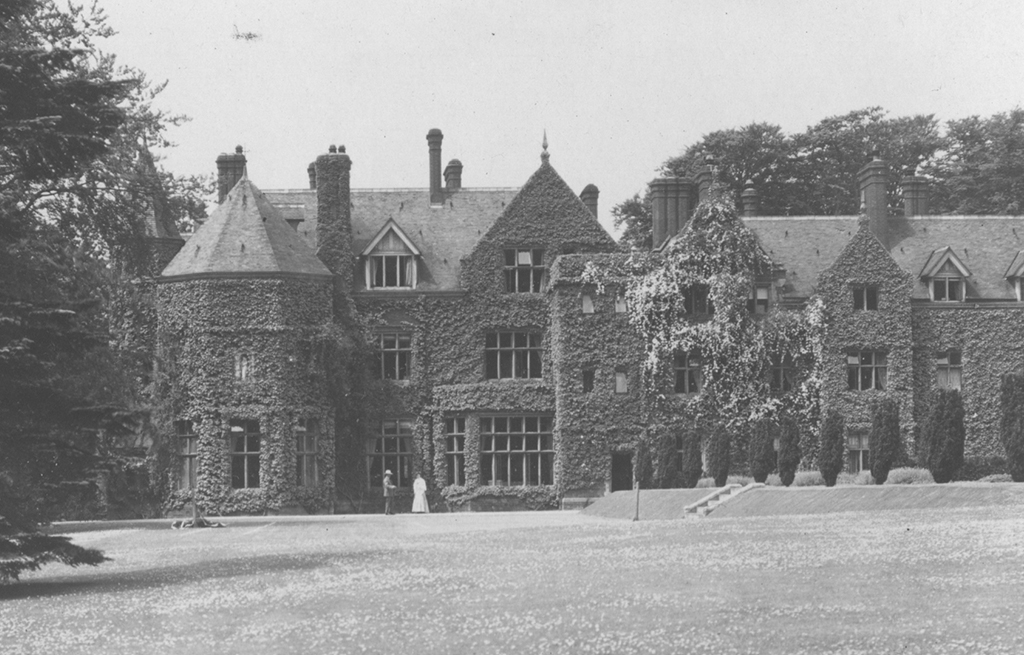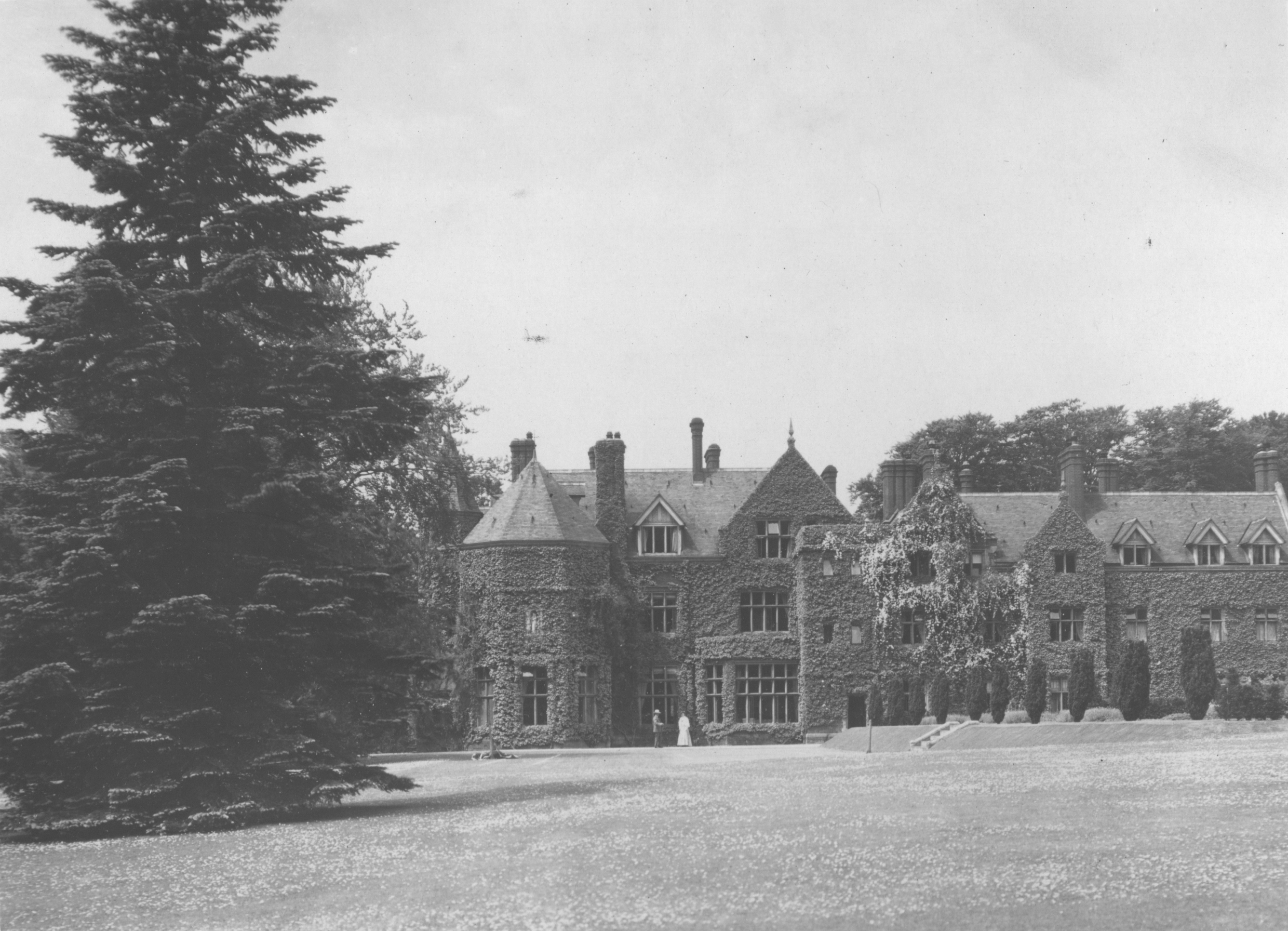Upstairs, Downstairs
Ditcham Park at the beginning of the twentieth century appears to have been a happy place to live and work. The Caves cared about their employees and, in return, they received gratitude and respect. They built a private school on the estate, at Park Barn, for the children of their employees. Dorothea Williamson, the daughter of the estate’s carter, was born at Sunwood Farm in 1902 and recalled that there were up to 30 children at the school. She remembers that the schoolmistress was a Miss Walcott, from Liverpool, and that she was ably assisted by a Miss Adcock who took care of the little ones as well as keeping house for her brother, the head gardener on the estate. Another teacher recalled by Dorothea was a Miss Alice Morgan. The school was closed in 1922.
Dorothea also had vivid recollections of Christmas at Ditcham when, on Boxing Day, the estate workers and their families would be invited to the house. “There would always be a bright Christmas tree, plenty of food and presents for the children and adults alike. The adults were usually given linen but the children could ask for anything they wanted”.
Victorians liked to impress their guests by displaying wealth and possessions and the Caves were probably no exceptions. Guests coming to dinner, the main form of social contact at the time, would step out of their carriages straight into the porch after being brought up the long drive which would show off the estate. And the house had been built with an impressive oak-panelled hall for greeting visitors and an elaborately carved staircase nearby. Both would probably require polishing by servants every day. The house was furnished with purchases made in Italy and included a bathroom with a covered bath so as not to offend the eye.
It was quite common for a family, when entertaining, to hire a professional pianist to play in the drawing room for the evening. On one notable occasion in December 1893, Ignacy Paderewski (a famous piano virtuoso and one-time Prime Minister of Poland) was brought from London to play at a dinner party at Ditcham House. As he was under contract to Bluthner, he insisted on bringing his own piano, refusing to play the Caves’ Bechstein. His instrument had to be carefully packed away and sent ahead of him by train and hauled all the way from Petersfield to Ditcham. It was then manhandled into the drawing room, unpacked, set up and re-tuned ready for his performance, all at the Caves’ expense.
Until World War Two there was a railway halt at the bottom of the South Drive. Apparently, the Caves could arrange for a train to stop there to take them up to London or to bring guests to Ditcham Park House, perhaps for shooting parties at weekends etc. This would avoid the five mile carriage ride from Petersfield. Sir Richard Cave, one of Captain Cave’s children, can recall the occasion that one of his aunt’s ‘came out’ at Ditcham and a special train was hired for the guests from London. It was arranged for it to stop at Woodcroft and at 1.am the driver was heard tooting, indicating that he was ready for the return journey.
The Cave family were prominent Catholics and played a large part in the building of a Catholic Church (St. Lawrence’s) in Petersfield. Ditcham House had a fine, tall chapel dedicated to Saint Philip Neri. Captain Charles Cave would read prayers in the chapel every morning whilst the family and any Catholic visitors would sit in the balcony and most of the indoor staff would stand downstairs. On Saturday evenings one of the servants, Mr Watts, would go into Petersfield to collect the priest from St. Lawrence’s. He would stay the night in a room next to the chapel and say mass the following morning for the family and servants.
At Ditcham there appears to have been a footman, butler, two under butlers, a pantry boy, cook, housekeeper, scullery-maid, between maid (one who both cooked and cleaned, looking after the servants), three housemaids, a kitchen maid (and at times even a second and third kitchen maid), a lady’s-maid, nurse, nursery-maid and schoolroom-maid. There were only five Caves living at the house; the need for so many servants to cater for them was partly the result of the high standard of food expected when catering for guests. It is some indication of the extravagance of Victorian food that it now takes less space and fewer staff to cook for all the school pupils than it did to cook for the Cave family and their servants.
The day to day supervision of the household staff was undertaken by Walter Wright, the butler, and Mrs Haseley, the Housekeeper. Mrs Haseley would generally supervise all the female staff and would be responsible to Mrs Cave. Mr Wright reported directly to Mr Cave. Mrs Haseley was also the cook and so she had to make sure that everything was kept well-stocked as well as doing the household accounts. She had her own room in the house which doubled as a work room and office.
The butler also had his own room but, being married, he also had a house at Park Barn. A number of other servants also lived away from the house at Park Barn: Mr Adcock (the head gardener) and one of the under-gardeners – both of whom had families. Living at Downley at the time of the 1891 census were Mr Watts (handyman and carrier) and Mr Dunkley (electrical engineer). The 1901 census shows Mr Watts still in residence at Downley along with Mr Pay (who was a woodsman and his wife worked in the laundry) and Mr Hayes (an electrical engineer whose wife was a kitchen-maid). Later residents of Downley include Mr Newman (coachman) and Mr Cresswell (engineer). Other woodsmen and gamekeepers, who maintained the woods to the west of the house, probably lived in lodges along the drives. The remainder of the servants ‘lived in’ – the maids probably in bedrooms on the top floor of the servants’ wing, some others in houses around the courtyard and some of the nursery staff probably lived in the children’s nursery. Captain Cave had three boys and two girls who would have eaten, played and slept in the nurseries – only seeing their parents when they came to visit them.
It is likely that employees who worked on the farms on the estate came under the control of Edwin Hill, the Bailiff, who lived at Old Ditcham Farm. Mr Hill had been instrumental in encouraging Joseph Williamson to move from Northampton, where he worked for the Duke of Buccleugh, and come to work at Ditcham in 1888 as a carter. Mr Williamson’s grandson still has a copies of letters offering Joe the job, at a wage of 17 shillings (85p) a week and offering Mrs Harriet Williamson work in the estate’s laundry and ‘as much wood as they wanted’. Another letter explains how they should travel down to Ditcham, changing trains in London, and tells them to let the railway company move all their furniture – to be paid for by Mr Cave. Because their furniture failed to arrive on the same train, they stayed with Mr Hill for their first few nights before moving into Sunwood Farm – their home for the next 32 years.
Joseph Williamson was, amongst other things, responsible for the ploughing and harvesting around Sunwood Farm and, during the first world war, his wife also worked in the fields – leaving their young daughter Dorothea to keep the home. Whilst working in 1917 Joe had an accident and broke his leg quite badly. It took two hours for the ambulance to arrive to take him to hospital but Mrs Cave waited with him all the time, keeping him dry with an umbrella.
Horses were very important to all families living in isolated houses like Ditcham. Before the arrival of motorised transport to Ditcham Park in about 1905, horses provided the only available means of transport. The family and their senior household staff would travel by horse-drawn coach or pony and trap. At the beginning of the twentieth century – Ditcham’s hey-day – the stables housed about eight horses and ponies; and four or five carriages and carts. The coaches and horses were looked after by a coachman (Mr Scarret) and a stable-boy, re-titled chauffeur and chauffeur’s mate when the Caves started owning cars. Captain Charles Cave, owned some of the first cars in the country – one with the number plate A3.
George Watts, the handyman and carrier, did the shopping in Petersfield or Harting for the house and for the occupants of Downley, Park Barn and the lodges. He was, apparently, unable to read or write and it was usual for him to collect the daily shopping list from the housekeeper and then drive the pony and trap to his home at Downley where his wife, Rhoda, would read the list to him and he would commit it to memory. Either he or the coachman would have collected visitors from the station or taken the family there when they went out.
Mr Watts was succeeded by George Newman who, in his younger days, had been one of a group of men responsible for maintaining and repairing the Estate’s four miles of roads. Mr. Newman’s grand-daughter, Christine Holmes, can recall that the horses he cared for were his pride and joy, and that their stables were spotlessly clean. Mr Newman used to go into Petersfield once a week with the horse-drawn carriage to do all the shopping. Milk came up to ‘the big house’, as it was known, in huge churns from Old Ditcham where cattle were kept.
Two of Mrs Holmes’ uncles also worked on the estate. Frank Newman was an assistant groomsman, working with his father, George. Arch was a gardener. Mrs Holmes can recall that there were very large gardens: “kitchen gardens which provided all the vegetables for ‘the big house’ and also extensive flower gardens – all immaculate, not a weed in sight”. The hand-mown parkland and lawns were quite vast and there was also a large orchard where children would enjoy going scrumping.
All the dwellings on the Ditcham Park Estate were built to house estate workers. At Downley there was also a laundry and a slaughter-house. The estate engineer, Mr Cresswell, lived in one of the dwellings there. He maintained the locally generated electricity supply and looked after the engine that pumped water up to a number of underground reservoirs near Ditcham Park House. The estate got its water supply from a 280’ bore-hole at Downley which still exists today. There used to be an ice-house in the field to the south of Ditcham Park House which was used to store ice brought in from Petersfield lake during the winter months. A nine-hole golf course was built on the estate in 1894 and one of the holes was known as “Icehouse Hole”. The main house also had a Racquets Court which, during the 1950s and 60s was used as a chicken coup. The chicken litter was nearly two feet deep when Ditcham Park School took over the property in 1976.
Mr Cave would have kept in direct touch with the Head Gamekeeper, Luke Gumbrell, as guests were often invited to come and shoot pheasants, partridges, rabbits and hares. The Gumbrell family were housed at Coulter’s Dean and later at North Lodge. Mr Gumbrell would plan where to raise all the birds and recommend which parts of the estate should be included in any particular shoot. He would also help to make sure that important guests were not placed in positions where they were unlikely to see many birds. Neighbouring tenant farmers were most likely to be allocated these positions!
Notes kept by the Cave family show that 1891-92 was a particularly good shooting season. “In former years the greatest number of pheasants shot was about 600. Last year it was over 800 and this season up till now [January 1892] 1,045 have been killed. Only 28 partridges have been got this season, but 61 hares is better than anticipated. The number of rabbits is over 340, a great many of which have been killed on West Harting Down. The woodcock only number about 3; the season does not seem to have been very favourable to them.”
Mr Gumbrell was supported by three Under Keepers, two of whom were brothers: Fred and Charlie Penton. Charlie later married Nellie Gumbrell, the elder daughter of his boss. Nellie had worked as a House Maid for Percy Seward at Weston Farm and died in 1982 aged 94. Mr Gumbrell was killed in an unfortunate cycling accident in 1910, having worked on the estate for thirty years. Harry Harrison came to Ditcham, with his wife Mary, about a year later and took on the role of Head Gamekeeper.
When the Caves sold the estate in 1922, they had the two ‘New Cottages’ built at Hurst for some of the estate workers. Joe and Harriet Williamson were given one and Mr Pearce, one of the gardeners, lived next door. These two cottages went with Old Ditcham Farm when the estate was split up and have subsequently been sold off.





